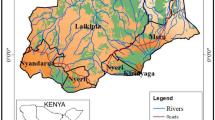Abstract
The Amite River is recognized as one of the 15 water bodies impaired by sediments in Louisiana, USA. Based on US EPA’s Protocol sediment TMDL (Total Maximum Daily Load) development is conducted for the Amite River and described in this paper. The TMDL development consists of four components: (1) development of a new model for cohesive sediment transport, (2) estimation of sediment loads (sources) due to watershed erosion, (3) river flow computation, and (4) determination of sediment TMDL for the Amite River. Using the mass conservation principle and Reynolds transport theorem a new 1-D model has been developed for computation of suspended cohesive sediment transport. Sediment erosion in the Amite River Basin is calculated by combining the USLE (Universal Soil Loss Equation) model with GIS and the digital elevation model of the Amite River Basin. Digital elevation data was imported into the GIS which generated inputs for USLE. The calculated average annual rate of soil erosion in the Amite River Basin is 13.368 tons per ha, producing a nonpoint sediment load of 103 mg/L to the Amite River. The flow computation is performed using the HEC-RAS software. The computed sediment concentration in the Amite River varies in the range of 3–114 mg/L and sediment TMDL is 281.219 tons/day. The reduction necessary to support beneficial uses of the river is 55% or 275.946 tons/day. Results indicate that the combined application of the new 1-D sediment transport model, GIS, USLE model, and HEC-RAS is an efficient and effective approach to sediment TMDL development.
Similar content being viewed by others
References
Chapra SC (2003) Engineering water quality models and TMDLs. J Water Resour Plan Manage 129(4):247–256
Chen NS (1997) Simplified settling velocity formula for sediment particle. J Hydraul Eng 123(2):149–152
Chien N, Wan Z (1999) Mechanics of sediment transport. ASCE, Reston
Chow VT, Maidment DR, Mays LW (1988) Applied hydrology. McGraw-Hill, New York, pp 20–57
Deng ZQ, Singh VP, Bengtsson L (2001) Longitudinal dispersion coefficient in straight rivers. J Hydraul Eng 127(11):919–927
Deng ZQ, Bengtsson L, Singh VP (2006) Parameter estimation for fractional dispersion model for rivers. Environ Fluid Mech 6(5):451–475
DePinto JV, Freedman PL, Dilks DM, Larson WM (2004) Models quantify the total maximum daily load process. J Environ Eng 130(6):703–713
Fistikoglu O, Harmancioglu NB (2002) Integration of GIS with USLE in assessment of soil erosion. Water Resour Manag 16(6):447–467
Haan CT, Barfield BJ, Hayes JC (1994) Design hydrology and sedimentology for small catchments. Academic, San Diego, pp 249–284
Hrissanthou V, Mylopoulos N, Tolikas D, Mylopoulos Y (2003) Simulation modeling of runoff, groundwater flow and sediment transport into Kastoria Lake, Greece. Water Resour Manag 17(3):223–242
Holly FM, Preissmann A (1977) Accurate calculation of transport in two dimensions. J Hydraul Div 103(11):1259–1277
Lung WS (2001) Water quality modeling for wasteload allocations and TMDLs. Wiley, New York
National Research Council (NRC) (2001) Assessing the TMDL approach to water quality management. National Academy, Washington, DC
Pandey A, Chowdary VM, Mal BC (2007) Identification of critical erosion prone areas in the small agricultural watershed using USLE, GIS and remote sensing. Water Resour Manag 21(4):729–746
Osterkamp WP, Heilman P, Lane LJ (1998) Economic considerations of a continental sediment-monitoring program. Int J Sediment Res 13(4):12–24
Raudkivi AJ (1990) Loose boundary hydraulics, 3rd edn. Pergamon, New York
USDA (1972) Sediment sources, yields, and delivery ratios. National Engineering Handbook, Section 3, Sedimentation
US Army Corps of Engineers (2000) Amite River and tributaries, Louisiana, ecosystem restoration and reconnaissance study
U.S. Environmental Protection Agency (EPA) (1999) Protocol for developing sediment TMDLs. EPA 841-B-99-004. Office of Water (4503F). United States Environmental Protection Agency, Washington, DC, 132 pp
Wischmeier WH, Smith DD (1978) Predicting rainfall erosion losses—a guide to conservation planning. The USDA Agriculture Handbook no. 537
Wu W (2004) Depth-averaged 2-D numerical modeling of unsteady flow and nonuniform sediment transport in open channels. J Hydraul Eng 130(10):1013–1024
Author information
Authors and Affiliations
Corresponding author
Rights and permissions
About this article
Cite this article
Mishra, P.K., Deng, ZQ. Sediment TMDL Development for the Amite River. Water Resour Manage 23, 839–852 (2009). https://doi.org/10.1007/s11269-008-9302-4
Received:
Accepted:
Published:
Issue Date:
DOI: https://doi.org/10.1007/s11269-008-9302-4




